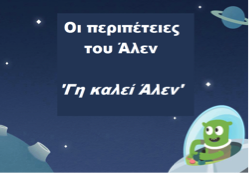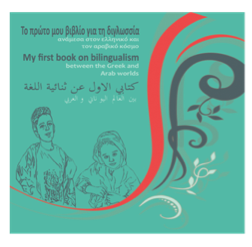Dealing with multiculturalism (age: 4-7)
Main Criteria:
• cooperative, create healthy and friendly environment
• empowering, built knowledge through real experiences
AIms:
• to recognise and show respect for similarities and differences
• to learn about identities and the things that contribute to our identity, including our membership of different groups
• to learn about their languages and the meaning for themselves
• to take turns in speaking and to respond appropriately to others
• learn that all children have basic needs and rights as human beings, regardless of their gender, ethnicity, language, size, ability
• to develop strategies to deal with prejudice, including racism, and to support others who encounter it
LINKS TO CURRICULUM:
Literacy in the language(s) of instruction.
PROCEDURE:
Sub-Activity 1
“The Allen adventure”

Allen is an Alien who is a Kid visiting earth.
How others will behave on him?
Can he communicate with others?
What kind of difficulties will face?
How others will interact with him?
These are some questions that help children to tackle with their misunderstandings, stereotypes and prejudices and help them to develop empathy, and respect differences and appreciate them.
The activity lasts 6-8 hours.
Students can ‘communicate’ with Allen or others to find solutions or to ‘teach’ others how to react to manage and control ‘main difficulties.
For example:
Children found other ways to communicate (with body language, pictures, drawing etc)
Children found ways how to behave and manage and control their own feelings and believes about the ‘Other’.
Questions for reflecting
What difficulties Allen will have now he is visiting earth?
What do you think will be the reaction of other people when will see him the first time?
How is he different? Are we all same or different?
Sub-Activity 2
“ My first book on bilingualism”

The special aims of the above activities were: the acquaintance of children with the neighbouring Arab culture and language, their meaningful communication with children from an Arab background of their classes and the tracing of children’s stereotypes concerning the Arab culture. In a broader educational context, we consider that the various activities of the Greek-Arabic project function as a means of developing multilingual skills and critical literacy (Cope & Kalantzis, 2000). Some of the communicative and cultural advantages of bilingualism (Baker, 2000), as the acknowledgement of multiculturalism, social tolerance and the restriction of prejudice against linguistic and cultural groups are presented in the book.
http://www.polydromo.gr/index.php/el-gr/my-first-book-on-bilingualism
Questions for reflecting
How do you find the language and culture of the Lebanon?
Do you find similarities with your own culture?
Can you give me some letters or words from the languages you know or use in your family? Can you find other students and children or families in your neighbourhood, who speak another language
EXPERIENCE IN STEPS
• Children recognise and identify things they have in common. Create a circle and join hands if they have common things e.g. Hair, language, family in another country etc
• At last all are in the same circle with common things they share or same teacher, class etc
• They discuss the things that they have in common and things that are different to them.
• They write down these similarities and differences in all languages they share in class. (additionally they found support from their family members)
• They draw a picture of themselves and a picture of their classmate
• They make a big puzzle with these portraits, the puzzle of their class
• They draw a sketch of their body and define which part represents each language, e.g. English: head, Greek: heart, etc
• They sit in the circle talking about things that make them happy and things that make them sad (the dialogue aims to find solution of how to act to protect and support someone that being hurt because he/she is different.
• They draw pictures and write emotions in all the languages support in class
Multimodal (TECHNOLOGICAL SUPPORT AND OTHER SUPPORT)
Projector, videos, creation of project with needs and rights I different languages including mother-tongue
Further development
• Cooperation and parents engagement to activities
• Cooperation with other classes (interclass relations)
Materials and digital tools
Baker, C. (2000) The care and education of young bilinguals. Multilingual Matters
Cope, B. & Kalantzis, M. (2000) (eds) Multiliteracies – Literacy Learning and the Design of Social Futures. London & New York: Routledge.